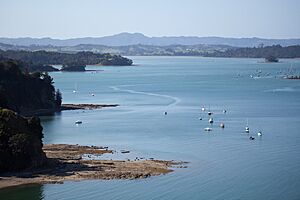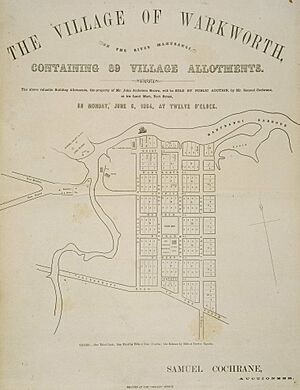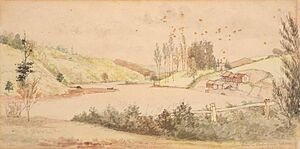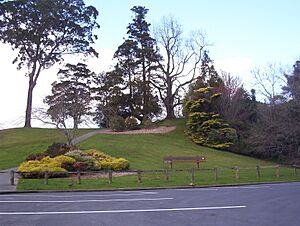Warkworth, New Zealand facts for kids
Quick facts for kids
Warkworth
Puhinui (Māori)
|
|
|---|---|
|
Town
|
|
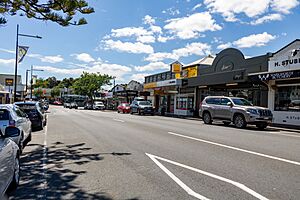
Queen Street, Warkworth, in 2024
|
|
| Country | New Zealand |
| Region | Auckland |
| Ward | Rodney ward |
| Local board | Rodney Local Board |
| Subdivision | Warkworth subdivision |
| Electorates |
|
| Area | |
| • Region | 15.58 km2 (6.02 sq mi) |
| Population
(June 2023)
|
|
| • Region | 6,730 |
| • Density | 432.0/km2 (1,118.8/sq mi) |
| Time zone | UTC+12 (NZST) |
| • Summer (DST) | UTC+13 (NZDT) |
| Postcode(s) |
0910
|
Warkworth (Māori: Puhinui) is a town in the northern part of the Auckland Region in New Zealand. It is on the Northland Peninsula of the North Island. The town is about 64 kilometers (40 miles) north of Auckland. It is also 98 kilometers (61 miles) south of Whangārei. Warkworth sits at the top of the Mahurangi Harbour. State Highway 1 runs right past the town.
The Mahurangi Harbour area has been home to Māori for a long time. They settled there since at least the 13th century. Warkworth is the highest point on the Mahurangi River where boats can travel. This made it a key meeting point between land routes and waka (canoes). The Māori name for the area is Puhinui. This name means "Big Plume" and refers to the waterfalls on the river. Māori people in the Mahurangi Harbour area moved around. They followed the seasons to find food. They came to the thick kauri forests at Puhinui. Here they found berries and eels. They also cut down trees to build their waka.
During the 17th and 18th centuries, several Māori groups lived in the Warkworth area. These included Ngāti Rongo, Ngāti Raupō, and Ngāti Manuhiri. The area became less populated during the Musket Wars in the 1820s. Many Te Kawerau hapū (sub-tribes) found safety with other tribes in the north. Ngāti Rongo returned to the area in 1836. Ngāti Manuhiri followed them in the early 1840s.
A European settler named John Anderson Brown arrived in Warkworth in 1843. He built a timber mill on the Mahurangi River. The town officially started in 1853. It quickly became important for timber and shipbuilding. In 1884, the Wilsons Cement Works opened, making the town a busy industrial center. By the 1930s, roads got better. Warkworth then became a place where people from nearby farms could get services and buy goods.
Warkworth and its surroundings hosted over 40 United States Army camps during World War II. In 1971, the Warkworth Radio Astronomical Observatory was built nearby. This observatory helps with long-distance communication. The town's population has grown a lot since the mid-2000s.
Contents
What's in a Name? The Story of Warkworth
Warkworth got its name in 1853 from an early settler. His name was John Anderson Brown. He named it after Warkworth in Northumberland, England. He said the Mahurangi River reminded him of the River Coquet there. A relative of his worked as a school headmaster in the English Warkworth. The main streets in Warkworth, New Zealand, are named after villages near Warkworth, England. Some are also named after important families from Northumberland.
Before 1853, the area was known as Brown's Mill. This was after John Anderson Brown's sawmill. Until the 1870s, the town was mostly called Upper Mahurangi. The traditional Māori name for Warkworth is Puhinui. This means "Big Plume" and refers to the Puhinui Waterfalls in the town.
Exploring Warkworth's Geography

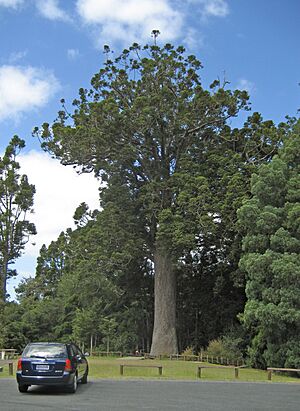
Warkworth is located at the highest point on the Mahurangi River where boats can travel. The river flows southeast into the Mahurangi Harbour. The town is where the river goes over a small waterfall. After this, it becomes a tidal estuary. The land around Warkworth is mostly made of Waitemata Group sandstone. In the past, the area was covered in thick forests. These forests were cleared after European settlers arrived.
The highest point in Warkworth is an 86-meter (282-foot) hill. It is between Falls Road and View Road. A water reservoir and a cellphone tower are on top of this hill.
East of the river is the Mahurangi Peninsula. Here you will find the seaside towns of Snells Beach and Algies Bay. The beautiful Kawau Island is also nearby. It is famous for its historic Mansion House. This house was once the private home of Governor Grey.
East of Warkworth is the Tāwharanui Peninsula. This area is home to the Tāwharanui Regional Park and Tawharanui Marine Park. To the north is the town of Wellsford. The thick Dome Valley forest lies between them. On the west coast is the Kaipara Harbour. To the south are the small historic town of Puhoi and the larger town of Orewa.
Warkworth's Climate and Weather
Warkworth has an oceanic climate. This means it has mild temperatures all year. It tends to be rainier in winter.
| Climate data for Warkworth (1991–2020 normals, extremes 1972–present) | |||||||||||||
|---|---|---|---|---|---|---|---|---|---|---|---|---|---|
| Month | Jan | Feb | Mar | Apr | May | Jun | Jul | Aug | Sep | Oct | Nov | Dec | Year |
| Record high °C (°F) | 29.5 (85.1) |
29.5 (85.1) |
28.3 (82.9) |
26.5 (79.7) |
22.9 (73.2) |
22.2 (72.0) |
19.4 (66.9) |
21.8 (71.2) |
23.5 (74.3) |
24.6 (76.3) |
26.8 (80.2) |
28.4 (83.1) |
29.5 (85.1) |
| Mean maximum °C (°F) | 26.8 (80.2) |
26.9 (80.4) |
25.4 (77.7) |
23.4 (74.1) |
21.0 (69.8) |
18.8 (65.8) |
17.3 (63.1) |
18.2 (64.8) |
19.5 (67.1) |
21.1 (70.0) |
23.0 (73.4) |
25.3 (77.5) |
27.4 (81.3) |
| Mean daily maximum °C (°F) | 23.1 (73.6) |
23.6 (74.5) |
22.2 (72.0) |
20.0 (68.0) |
17.6 (63.7) |
15.3 (59.5) |
14.4 (57.9) |
14.9 (58.8) |
16.2 (61.2) |
17.6 (63.7) |
19.2 (66.6) |
21.4 (70.5) |
18.8 (65.8) |
| Daily mean °C (°F) | 18.5 (65.3) |
18.9 (66.0) |
17.5 (63.5) |
15.4 (59.7) |
13.4 (56.1) |
11.4 (52.5) |
10.4 (50.7) |
10.9 (51.6) |
12.2 (54.0) |
13.5 (56.3) |
14.9 (58.8) |
17.1 (62.8) |
14.5 (58.1) |
| Mean daily minimum °C (°F) | 13.8 (56.8) |
14.2 (57.6) |
12.8 (55.0) |
10.9 (51.6) |
9.3 (48.7) |
7.5 (45.5) |
6.3 (43.3) |
6.8 (44.2) |
8.2 (46.8) |
9.4 (48.9) |
10.6 (51.1) |
12.7 (54.9) |
10.2 (50.4) |
| Mean minimum °C (°F) | 8.2 (46.8) |
9.1 (48.4) |
7.5 (45.5) |
4.7 (40.5) |
2.8 (37.0) |
0.6 (33.1) |
−0.1 (31.8) |
1.0 (33.8) |
2.2 (36.0) |
4.1 (39.4) |
4.7 (40.5) |
6.8 (44.2) |
−0.8 (30.6) |
| Record low °C (°F) | 5.7 (42.3) |
6.6 (43.9) |
4.0 (39.2) |
−0.3 (31.5) |
−1.4 (29.5) |
−2.8 (27.0) |
−2.3 (27.9) |
−1.4 (29.5) |
−0.5 (31.1) |
1.0 (33.8) |
2.7 (36.9) |
3.5 (38.3) |
−2.8 (27.0) |
| Average rainfall mm (inches) | 74.2 (2.92) |
85.6 (3.37) |
104.9 (4.13) |
112.1 (4.41) |
137.9 (5.43) |
156.0 (6.14) |
176.2 (6.94) |
149.4 (5.88) |
130.3 (5.13) |
95.7 (3.77) |
82.5 (3.25) |
102.2 (4.02) |
1,407 (55.39) |
| Source: NIWA | |||||||||||||
Warkworth's Rich History
Māori History and Early Settlement
The wider Mahurangi area has been settled since at least the 13th century. Local stories say that Toi-te-huatahi was the first ancestor for the Mahurangi people. Many places are named after Toi, like Little Barrier Island / Te Hauturu-o-Toi. The Hauraki Gulf (Te Moananui-ā-Toi) is also named after him. One of the first known iwi (tribes) to live here was Ngāi Tāhuhu. They were named after Tāhuhunui-o-te-rangi, who was the captain of the Moekākara waka. This iwi also lived in Ōtāhuhu in Auckland, Whangārei, and the Bay of Islands.
The Te Arawa and Tainui migratory waka visited this area. Descendants of Manaia, captain of the Māhuhu-ki-te-rangi waka, married into Ngāi Tāhuhu. A special place near Warkworth is Tohitohi ō Reipae. This is the peak of the Dome Forest. It was used as a traditional boundary marker. It is also where the Tainui ancestress Reipae married the Ngāi Tāhuhu chief Tahuhupotiki.
The Mahurangi people mostly lived along the shores of the Hauraki Gulf. They moved with the seasons to find different resources. Puhinui was an important meeting point. It was the highest place on the river where waka could travel. This led to many overland paths. Most old archaeological sites near Warkworth are on the Mahurangi Harbour coast. However, the Mahurangi River (called Waihē in Māori) and its forests were also used. People collected berries, snared birds, harvested flax, fished for eels, and cut trees for waka.
Arrival of Maki and New Hapū
In the mid-17th century, a warrior named Maki came from the Kāwhia Harbour. He returned to his family's home in the Auckland Region. Maki brought together many Tāmaki Māori tribes. These included tribes from West Auckland, the North Shore, and Mahurangi. He united them under the name Te Kawerau. In Mahurangi, he did this by conquering Ngāi Tāhuhu. He also made peace through marriages with the Te Roroa and Ngāti Manaia/Ngātiwai tribes. These tribes were moving from the north.
After Maki died, his sons settled in different parts of his lands. They formed new hapū (sub-tribes). These included the Mahurangi hapū of Ngāti Rongo, Ngāti Raupō, Ngāti Manuhiri, Ngāti Maraeariki, Ngāti Poataniwha, and Ngāti Kahu.
Ngāti Rongo was formed when Maki's son Ngāwhetu married Moerangaranga of Ngā Rīriki. Moerangaranga is also an ancestor for Te Uri-o-Hau of Ngāti Whātua. Ngāti Raupō are descendants of Maki's son Maraeariki. They settled on the Tāwharanui Peninsula. Ngāti Manuhiri settled the Whangateau Harbour north to Pākiri. As these hapū grew, Ngātiwai formed strong connections with Kawerau hapū. This happened through many generations of intermarriage.
By the mid-1700s, Marutūāhu tribes from the Hauraki Gulf wanted to control the shark fishing. This fishing area was on the Mahurangi coast. It was between Kawau Island and the Whangaparāoa Peninsula. War broke out between Ngāti Pāoa and the Kawerau hapū. By the early 19th century, Kawerau-descended hapū had special land rights in Mahurangi. Fishing rights were shared between these hapū and the Marutūāhu tribes.
By the early 19th century, Ngāti Rongo and their related hapū, Ngāti Kā and Ngāti Raupō, mainly lived in the Mahurangi Harbour. They stayed close to Ngāti Manuhiri. Marutūahu tribes often visited the coast in summer.
Musket Wars and European Arrivals

In the early 1820s, during the Musket Wars, northern tribes attacked Mahurangi. This was in response to past conflicts. The Mahurangi area became less populated. Ngāti Rongo, about 100 people, found safety with their Ngāti Manu relatives. They went to the Bay of Islands under Pōmare II. Ngāti Raupō went to Whangārei with Te Parawhau and Te Whareumu. Ngāti Mahuhiri went north of Whangārei with Ngātiwai.
In 1832, Gordon Browne set up a spar station on the Pukapuka Peninsula. This was in the Mahurangi Harbour. Browne got permission to cut kauri trees from Marutūāhu tribes. Then, Ngāpuhi chiefs Patuone and Tītore made a deal. They worked with the British Royal Navy to supply kauri spars for navy ships. This station was the first European settlement in the Auckland Region. Most workers were from Ngāti Pāoa and Ngāpuhi. The station operated until 1834. It was often disputed by Kawerau descendant hapū.
Ngāti Rongo returned to Mahurangi in 1836. Their leader was Te Hēmara Tauhia. They settled at Te Muri. Ngāti Rongo and Ngāti Raupō lived in modern Warkworth by the late 1830s or early 1840s. Ngāti Mahuhiri likely returned in the early 1840s. By this time, many Kawerau hapū had ties with Ngāti Whātua. The Mahurangi area was claimed by Kawerau, Ngāti Whātua, and Marutūāhu tribes.
Land Sales and Early European Settlement
After the Treaty of Waitangi was signed in 1840, the Crown bought land. The first purchases of the Mahurangi and Omaha blocks happened on April 13, 1841. This included the Mahurangi Harbour. Some iwi and hapū were involved, like Ngāti Paoa. But Ngāti Rongo, Ngāti Raupō, and Ngāti Manuhiri were not part of this deal. It took the Crown until the 1850s to make a deal with these tribes. Te Hemara Tauhia and his people continued to live on their lands at Te Muri.
In 1843, John Anderson Brown started living on land along the Mahurangi River. He built a dam and timber mill there in 1844. The timber industry was very important. Shipbuilding also became a major activity in the mid-19th century. In 1853, Warkworth was planned as a new settlement. Brown and his daughter Amelia bought 234 acres of land from the Crown. The town grew slowly, mostly around the Mahurangi River wharf. Settlers could send goods to Auckland from here. Bridge House Lodge is the oldest building still standing in Warkworth. It was built on the site of John Anderson Brown's home.
The Mahurangi Post Office and Library opened in 1859. The first local government, the Mahurangi Highway Board, started in 1863. The Mahurangi School opened in the same year. By 1868, Henry Palmer had built a flour mill. Shipbuilding slowed down in the late 1870s and stopped in 1880. Unlike other northern areas, kauri gum digging was not a big part of Warkworth's economy. Orchards were planted around Warkworth, and some are still active today.
In 1883, the Masonic Hall was built. It was used as a public hall until 1911. Then, a new building was made for public events.
Ngāti Rongo remained in the area in the 19th century. They lost land in the Mahurangi Purchase. However, a native reserve was set up between Pukapuka and Waiwera in 1853. Land in this reserve was slowly sold to settlers. When Te Hemara Tauhia died in 1891, his Ngāti Rongo family moved to Glorit. Today, 13 iwi and groups have interests in Warkworth. Ngāti Manuhiri are considered mana whenua. This means they have historic and territorial rights in the area.
Lime and Cement Works
John Sullivan started Warkworth's first lime production in 1849. John Southgate opened another limeworks in 1857. He sold it to Nathaniel Wilson in 1864.
Wilson became interested in cement in 1883. He started the Wilsons Cement Works in 1884 with his brothers John and James. This was the first portland cement factory in the Southern Hemisphere. The company built the Warkworth Bridge in 1899.
By 1910, the cement company was one of the biggest employers in Warkworth. In 1918, it joined with the New Zealand Portland Cement Company. That company was based in Motu Matakohe – Limestone Island in Whangārei. The Warkworth operations slowly moved to Whangārei. They finally closed completely in 1929. Ruins of the old works remain. The mine is now a popular swimming spot.
World War II and Modern Growth

By 1933, the road to Auckland was much better. The town no longer needed boats to transport goods. The steamer service stopped in 1937. After this, Warkworth changed. It became a center for business and services for the wider north Auckland area. Logging continued in Warkworth until the 1930s.
During World War II, Warkworth and nearby areas had over 40 camps. These camps housed United States Army soldiers. The 3rd Marine Division, 25th Infantry Division, and 43rd Infantry Division were among them. The first soldiers arrived in October 1942. Camps were set up at places like the Rodney Showgrounds. A military hospital was built near Hill Street. The old cement works, closed since 1928, were used for demolition practice. By 1944, the US Army had left. The New Zealand Army then took over many of the camps.
In 1971, the Warkworth Radio Astronomical Observatory was built. It was New Zealand's first major center for satellite phone and TV. By 2010, the facility became an AUT radio observatory.
The Warkworth & District Museum opened in 1980. It shows the local history of the area. Warkworth saw a lot of new housing built between 2008 and 2018. Its population grew by 61% in that time. In 2023, the Auckland Northern Motorway extension opened. This new road helps traffic avoid Warkworth. The town is expected to triple in size by the late 2040s.
Warkworth's Population and Community
Warkworth is a small urban area. It covers 15.58 square kilometers (6.02 sq mi). As of June 2023, its estimated population was 6,730. This means there are about 432 people per square kilometer.
| Historical population | ||
|---|---|---|
| Year | Pop. | ±% p.a. |
| 2006 | 3,462 | — |
| 2013 | 4,269 | +3.04% |
| 2018 | 5,586 | +5.52% |
| 2023 | 6,675 | +3.63% |
In the 2023 New Zealand census, Warkworth had 6,675 people. This was an increase of 1,089 people (19.5%) since the 2018 census. It was an increase of 2,406 people (56.4%) since the 2013 census. There were 3,231 males and 3,429 females. The median age was 43.2 years. About 18.5% of people were under 15 years old. 14.2% were aged 15 to 29. 41.1% were aged 30 to 64. And 26.2% were 65 or older.
People could choose more than one ethnicity. The results showed 82.9% European (Pākehā). 10.7% were Māori. 7.3% were Pasifika. 8.4% were Asian. 1.3% were Middle Eastern, Latin American and African New Zealanders (MELAA). And 2.1% were other ethnicities. English was spoken by 95.9% of people. Māori language was spoken by 1.3%. Other languages were spoken by 13.7%.
About 37.3% of people were Christian. 51.2% said they had no religion.
Of those aged 15 and over, 15.3% had a university degree. 52.5% had a post-high school certificate or diploma. 26.8% had only high school qualifications. The average income was $38,300. About 46.1% of people aged 15 and over worked full-time. 13.1% worked part-time. 1.7% were unemployed.
| Name | Area (km2) |
Population | Density (per km2) |
Dwellings | Median age | Median income |
|---|---|---|---|---|---|---|
| Warkworth West | 11.36 | 2,775 | 244 | 1,125 | 47.8 years | $35,000 |
| Warkworth East | 4.22 | 3,900 | 924 | 1,446 | 40.6 years | $40,700 |
| New Zealand | 38.1 years | $41,500 |
Education in Warkworth
Mahurangi College: A Secondary School
Mahurangi College is a school for both boys and girls. It teaches students from Year 7 to Year 13. As of February 2024, it has a roll of 1,525 students. The school was first built on its current site in 1957. It was then called Warkworth District High School. In 1962, it was renamed Mahurangi College. At that time, it had 210 students.
Many famous people have attended Mahurangi College. Yacht designer Bruce Farr was one of the first students. All Black rugby players Zinzan Brooke and his brother Robin Brooke went there. Cricket twins Hamish Marshall and James Marshall also attended. They played for the New Zealand Black Caps Cricket Team. Ruahei Demant, a Black Fern and the women's rugby World Player of the Year in 2022, is also a former student.
A new auditorium was finished in January 2011. In early 2012, work started on rebuilding B-block and a new office area. These renovations were completed in mid-2013. In 2015, a $6.3 million property upgrade was announced for the college.
Warkworth School: A Primary School
Warkworth School is a primary school for both boys and girls. It teaches students from Year 1 to Year 6. As of February 2024, it has a roll of 466 students.
Sports and Festivals in Warkworth
Mahurangi RFC is the local rugby club. It was formed in 1989. It combined three local rugby clubs: Warkworth, Kaipara Flats, and Omaha.
Warkworth also has a special event called the Kōwhai Festival. This festival happens when kōwhai trees start to drop their yellow flowers. This is usually in September or October. Thousands of visitors come to enjoy the festival. It features old horse carriages, markets, and live bands.
Notable People from Warkworth
- Lucy Moore was a botanist. She came from an early settler family. The Lucy Moore Memorial Park is named in her honor.
- Harry Parry (?–1977) helped get land for a park with kauri trees. The Parry Kauri Park is named after him.
- Serj Tankian is a singer and songwriter. He is a member of the band System of a Down.
- Conrad Robertson is an Olympic gold medalist.
Getting Around Warkworth: Transportation
State Highway 1 used to go through Warkworth. However, a new part of the Auckland Northern Motorway opened in July 2023. This new motorway now ends just north of Warkworth.
There was a very busy intersection in Warkworth called "the worst in New Zealand." This was where the old SH1 met Hill Street. It was planned to be replaced in 2024. But this plan was removed by NZTA. It did not fit with the National Government's road plans.
Warkworth has buses that run every hour to Hibiscus Coast Station. There are also less frequent buses to Snells Beach, Algies Bay, Matakana, Ōmaha, and Point Wells. InterCity buses travel through Warkworth. They go from Auckland to Kerikeri. The Mahu City Express also goes to Auckland twice a day.
Warkworth's Sister Towns
Warkworth has several sister towns. These are towns that have a special friendship connection:
- Warkworth, Northumberland, England: The town founder, John Anderson Brown, named Warkworth after his old home in England.
- Furudono, Fukushima, Japan: Furudono is a sister school to Mahurangi College and Warkworth Primary School. It is located in Honshū, Japan.
- Warkworth, Ontario, Canada: This town in Canada became a sister town in 2003.



